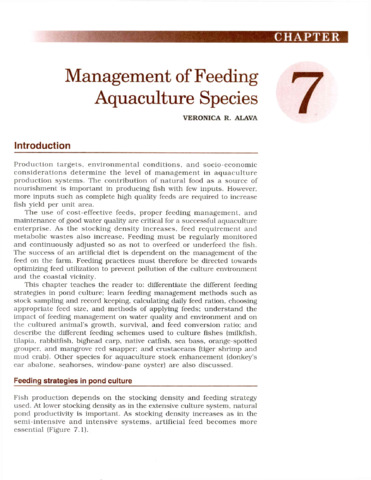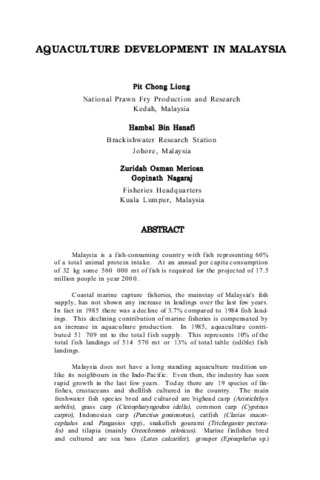Breeding and culture of the polychaete, Marphysa mossambica, as feed for the mud crab
- Global styles
- MLA
- Vancouver
- Elsevier - Harvard
- APA
- Help

Date
2017Page views
47,197ASFA keyword
AGROVOC keyword
Taxonomic term
Metadata
Show full item record
Share
Abstract
Marine worms (Annelida: Polychaeta) are considered as important food for crustacean broodstock because they contain hormones and correct balance of essential nutrients for reproduction. Marphysa mossambica (Peters, 1854) occurs in muddy coastal areas and is abundant in fish farms where it builds burrows in nutrient-rich sediments. This species encapsulates their eggs and larvae in gelatinous masses (jelly cocoons). It is a multiple spawner, and breeders are repeatedly spawning in tanks. Culture techniques have also been developed and established in tanks. Based on dry weight, cultured M. mossambica contained 62-66% crude protein and 7-12% lipids with levels of highly unsaturated fatty acids (HUFAs) such as arachidonic (20:4n-6), eicosapentaenoic (20:5n-3) and docosahexaenoic acid (22:6n-3) at 0.2-0.5%, 0.2-0.3% and 0.3-0.5%, respectively. Stocks were monitored for the presence of white spot syndrome virus (WSSV) using polymerase chain reaction-based diagnostic methods. The WSSV-free polychaetes mass-produced in tanks were utilized as live food for mud crab S. serrata broodstock. Mud crab broodstock fed natural food (mussel, fish, and squid) with live Marphysa on daily feed rotation produced higher number of crab zoeae, larval survival, total lipids and HUFAs than those fed natural food without live Marphysa. Production of nutrient-rich WSSV-free polychaetes in captivity can play a significant role in supporting crustacean hatcheries that supply seeds to the nursery and grow-out.
Suggested Citation
Alava, V. R., Biñas, J. B., & Mandario, M. A. E. (2017). Breeding and culture of the polychaete, Marphysa mossambica, as feed for the mud crab. In E. T. Quinitio, F. D. Parado-Estepa, & R. M. Coloso (Eds.), Philippines : In the forefront of the mud crab industry development : proceedings of the 1st National Mud Crab Congress, 16-18 November 2015, Iloilo City, Philippines (pp. 39–45). Tigbauan, Iloilo, Philippines: Aquaculture Department, Southeast Asian Fisheries Development Center.
Type
Conference paperISBN
9789719931072Collections
Related items
Showing items related by title, author, creator and subject.
-
Aquaculture development in Thailand
Sirikul, Boonsong; Luanprida, Somsak; Chaiyakam, Kanit; Sriprasert, Revadee (Aquaculture Department, Southeast Asian Fisheries Development Center, 1988)Aquaculture practised in Thailand is in the form of pond culture and cage culture in freshwater, brackishwater and coastal areas. The main species cultured include freshwater prawns, brackishwater shrimp, cockles, mussels, ... -
Management of feeding aquaculture species
Alava, Veronica R. (Aquaculture Department, Southeast Asian Fisheries Development Center, 2002)This chapter teaches the reader to: differentiate the different feeding strategies in pond culture; learn feeding management methods such as stock sampling and record keeping, calculating daily feed ration, choosing ... -
Aquaculture development in Malaysia
Liong, Pit Chong.; Hanafi, Hambal Bin.; Merican, Zuridah Osman.; Nagaraj, Gopinath. (Aquaculture Department, Southeast Asian Fisheries Development Center, 1988)Malaysia is a fish-consuming country with fish representing 60% of a total animal protein intake. At an annual per capita consumption of 32 kg some 560 000 mt of fish is required for the projected of 17.5 million people ...







